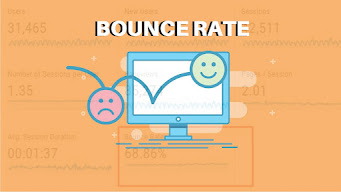Web Metrics: Conversion Rate
(Sayed, n.d.)
Before we dive into the importance of tracking, understanding, and optimizing websites to increase conversion rates, it’s important to first define a conversion.
A conversion is “the number of times a desired outcome was accomplished” (Reed College of Media, 2021). Some examples of conversions include filling out a form, signing up for emails or other information, clicking on a specific button, or making a purchase (Storm, 2020).
A Conversion Rate is a percentage that “equals outcomes divided by unique visitors during a particular time period.” There are different outcomes that can be used in this equation like the total numbers of orders submitted, the total number of email or newsletter sign-ups, and the total number of leads (Kaushik, 2006).
The average conversion rate across industries is anywhere from 2.35% to 5.31%. This can differ depending on the industry. For example, a mobile app store page may reach a conversion rate of 26.4% (Geckoboard, n.d.).
(Geckoboard, n.d.)
Conversion rates can help businesses determine if their website is optimized for success. There are three main things that can lead to higher conversion rates: the business is attracting the right audience for their product or service; the copy and messaging/calls to action/graphics, and other pieces of marketing and content are resonating with the audience; and the businesses have simplifies the user’s journey and experience (Geckoboard, n.d.).
On the other hand, businesses that have a low conversion rate can learn valuable information from this data. A low conversion rate means that there’s most likely a problem that’s causing people not to complete the desired action. This is where web metrics can save the day. Analyzing the data can help businesses to better understand where things are going wrong and how to fix them, which ultimately sets them up to achieve their goals and objectives.
Some things that can cause low conversion rates include (Geckoboard, n.d.):
• Slow page load time
• A broken form
• Irrelevant or boring copy
• Attracting the wrong audience
• Lack of value in an offer
Here’s an example to show how optimizing a website can lead to a higher conversion rate.
Lifeproof sells protective accessories for electronics such as phones and tablets. Their main goal is for people to purchase their products. The company decided to experiment with different call-to-actions on their homepage to see if this would influence their customer’s decisions and behavior. Lifetime promoted three different versions of copy in a button on their homepage: store, show now, and shop. These options aren’t too different, but they had a significant impact (Young, n.d.).
Can you guess which one worked best?
Lifetime found that promoting the action of “Shop Now” was way more effective than promoting the homepage with the “Store” button. The “Shop Now” button resulted in a 16% increase in monthly revenue. Just from the simple change of copy (Young, n.d.).
Web metrics are an important way to listen and observe the behavior of your audience to see what they want or need. When businesses optimize their website to increase accessibility and the user experience, it can increase conversion rate and trust among customers.
References:
Geckoboard. (n.d.). Website conversion rate. Retrieved from
https://www.geckoboard.com/best-practice/kpi-examples/website-conversion- rate/#:~:text=Website%20conversion%20rates%20have%20quite,between%202.35%25%20and%205.3 1%25..
Kaushik, A. (2006, July 31). Excellent analytics tip #5: Conversion rate basics and best practices. Occam’s Razor. Retrieved from
https://www.kaushik.net/avinash/excellent-analytics-tip5-conversion-rate-basics-best-practices/.
Reed College of Media (2021). Week 1 lesson: Intro to web analytics and the basics of web analytics.
Retrieved from https://ecampus.wvu.edu/webapps/blackboard/execute/displayLearningUnit?
course_id=_155927_1&content_id=_7582539_1&framesetWrapped=true.
Sayed, S. (n.d.). Omnikick Blog: How to measure and improve your conversion rates. Omnikick.
Retrieved from https://www.omnikick.com/measure-improve-conversion-rates/.
Storm, M. (2020, February 14). What is website conversion? [+5 ways to improve conversions]. WebFX.
Retrieved from https://www.webfx.com/blog/web-design/what-is-website-conversion/.
Young, T. (n.d.). Optimizely blog: 13 Ecommerce conversion optimization examples. Optimizely.
Retrieved from https://blog.optimizely.com/2015/06/04/ecommerce-conversion-optimization-case- studies/.




I think that slow load times on web pages is greatly overlooked - especially in e-commerce situations. Google heavily penalizes sites that have slow load times, which ultimately hurts your SEO. The chances of a visitor dropping by your page and bouncing off greatly increases because simply put, people aren't trained to have patience when everything in society is highly accessible at *most* times of the day. According to Patel (2018), 53% of mobile users leave a site that takes longer than three seconds to load. That data was released by Google in 2018, and I would be willing to bet that percentage is higher in 2021 than it was in 2018.
ReplyDeleteReferences
Patel, N. (2018). Speed is A Killer: Why Decreasing Page Load Time Can Drastically Increase Conversions. Neil Patel. Retrieved from https://neilpatel.com/blog/speed-is-a-killer/
Hi Erin,
DeleteThanks for the great information! That's very powerful to see how many people will leave a site after just three seconds. I agree that this number is probably higher today because people are used to instant gratification and having everything available at their fingertips.
I didn't know that slow load times can have such a great impact on SEO, so that's great to know. Thanks again!!